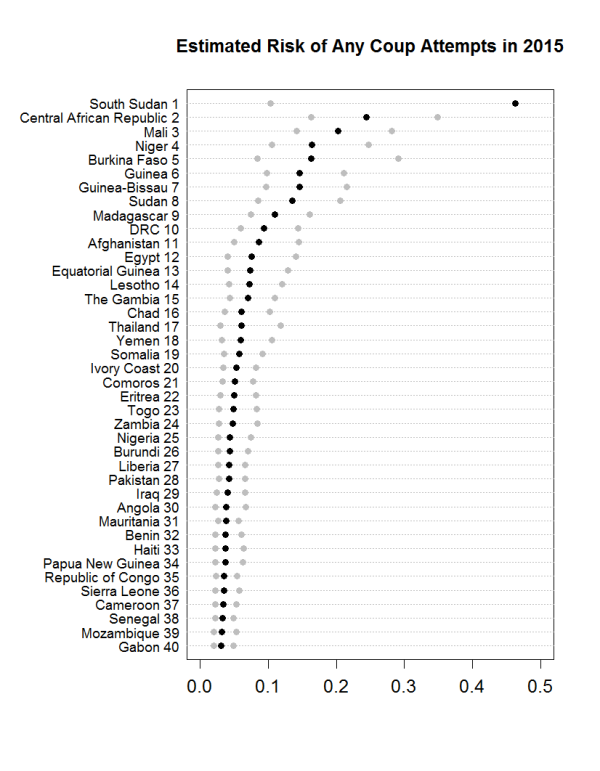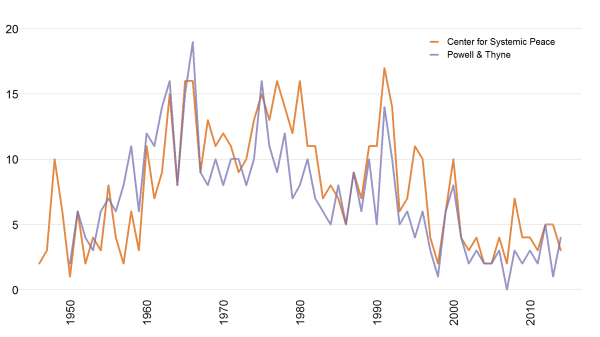Which countries around the world are more likely to see coup attempts in 2015?
For the fourth year in a row, I’ve used statistical models to generate one answer to that question, where a coup is defined more or less as a forceful seizure of national political authority by military or political insiders. (I say “more or less” because I’m blending data from two sources with slightly different definitions; see below for details.) A coup doesn’t need to succeed to count as an attempt, but it does need to involve public action; alleged plots and rumors of plots don’t qualify. Neither do insurgencies or foreign invasions, which by definition involve military or political outsiders. The heat map below shows variation in estimated coup risk for 2015, with countries colored by quintiles (fifths).
The dot plot below shows the estimates and their 90-percent confidence intervals (CIs) for the 40 countries with the highest estimated risk. The estimates are the unweighted average of forecasts from two logistic regression models; more on those in a sec. To get CIs for estimates from those two models, I took a cue from a forthcoming article by Lyon, Wintle, and Burgman (fourth publication listed here; the version I downloaded last year has apparently been taken down, and I can’t find another) and just averaged the CIs from the two models.
I’ve consistently used simple two– or three-model ensembles to generate these coup forecasts, usually pairing a logistic regression model with an implementation of Random Forests on the same or similar data. This year, I decided to use only a pair of logistic regression models representing somewhat different ideas about coup risk. Consistent with findings from other work in which I’ve been involved (here), k-fold cross-validation told me that Random Forests wasn’t really boosting forecast accuracy, and sticking to logistic regression makes it possible to get and average those CIs. The first model matches one I used last year, and it includes the following covariates:
- Infant mortality rate. Deaths of children under age 1 per 1,000 live births, relative to the annual global median, logged. This measure that primarily reflects national wealth but is also sensitive to variations in quality of life produced by things like corruption and inequality. (Source: U.S. Census Bureau)
- Recent coup activity. A yes/no indicator of whether or not there have been any coup attempts in that country in the past five years. I’ve tried logged event counts and longer windows, but this simple version contains as much predictive signal as any other. (Sources: Center for Systemic Peace and Powell and Thyne)
- Political regime type. Following Fearon and Laitin (here), a categorical measure differentiating between autocracies, anocracies, democracies, and other forms. (Source: Center for Systemic Peace, with hard-coded updates for 2014)
- Regime durability. The “number of years since the last substantive change in authority characteristics (defined as a 3-point change in the POLITY score).” (Source: Center for Systemic Peace, with hard-coded updates for 2014)
- Election year. A yes/no indicator for whether or not any national elections (executive, legislative, or general) are scheduled to take place during the forecast year. (Source: NELDA, with hard-coded updates for 2011–2015)
- Economic growth. The previous year’s annual GDP growth rate. To dampen the effects of extreme values on the model estimates, I take the square root of the absolute value and then multiply that by -1 for cases where the raw value less than 0. (Source: IMF)
- Political salience of elite ethnicity. A yes/no indicator for whether or not the ethnic identity of national leaders is politically salient. (Source: PITF, with hard-coded updates for 2014)
- Violent civil conflict. A yes/no indicator for whether or not any major armed civil or ethnic conflict is occurring in the country. (Source: Center for Systemic Peace, with hard-coded updates for 2014)
- Country age. Years since country creation or independence, logged. (Source: me)
- Coup-tagion. Two variables representing (logged) counts of coup attempts during the previous year in other countries around the world and in the same geographic region. (Source: me)
- Post–Cold War period. A binary variable marking years after the disintegration of the USSR in 1991.
- Colonial heritage. Three separate binary indicators identifying countries that were last colonized by Great Britain, France, or Spain. (Source: me)
The second model takes advantage of new data from Geddes, Wright, and Frantz on autocratic regime types (here) to consider how qualitative differences in political authority structures and leadership might shape coup risk—both directly, and indirectly by mitigating or amplifying the effects of other things. Here’s the full list of covariates in this one:
- Infant mortality rate. Deaths of children under age 1 per 1,000 live births, relative to the annual global median, logged. This measure that primarily reflects national wealth but is also sensitive to variations in quality of life produced by things like corruption and inequality. (Source: U.S. Census Bureau)
- Recent coup activity. A yes/no indicator of whether or not there have been any coup attempts in that country in the past five years. I’ve tried logged event counts and longer windows, but this simple version contains as much predictive signal as any other. (Sources: Center for Systemic Peace and Powell and Thyne)
- Regime type. Using the binary indicators included in the aforementioned data from Geddes, Wright, and Frantz with hard-coded updates for the period 2011–2014, a series of variables differentiating between the following:
- Democracies
- Military autocracies
- One-party autocracies
- Personalist autocracies
- Monarchies
- Regime duration. Number of years since the last change in political regime type, logged. (Source: Geddes, Wright, and Frantz, with hard-coded updates for the period 2011–2014)
- Regime type * regime duration. Interactions to condition the effect of regime duration on regime type.
- Leader’s tenure. Number of years the current chief executive has held that office, logged. (Source: PITF, with hard-coded updates for 2014)
- Regime type * leader’s tenure. Interactions to condition the effect of leader’s tenure on regime type.
- Election year. A yes/no indicator for whether or not any national elections (executive, legislative, or general) are scheduled to take place during the forecast year. (Source: NELDA, with hard-coded updates for 2011–2015)
- Regime type * election year. Interactions to condition the effect of election years on regime type.
- Economic growth. The previous year’s annual GDP growth rate. To dampen the effects of extreme values on the model estimates, I take the square root of the absolute value and then multiply that by -1 for cases where the raw value less than 0. (Source: IMF)
- Regime type * economic growth. Interactions to condition the effect of economic growth on regime type.
- Post–Cold War period. A binary variable marking years after the disintegration of the USSR in 1991.
As I’ve done for the past couple of years, I used event lists from two sources—the Center for Systemic Peace (about halfway down the page here) and Jonathan Powell and Clayton Thyne (Dataset 3 here)—to generate the historical data on which those models were trained. Country-years are the unit of observation in this analysis, so a country-year is scored 1 if either CSP or P&T saw any coup attempts there during those 12 months and 0 otherwise. The plot below shows annual counts of successful and failed coup attempts in countries worldwide from 1946 through 2014 according to the two data sources. There is a fair amount of variance in the annual counts and the specific events that comprise them, but the basic trend over time is the same. The incidence of coup attempts rose in the 1950s; spiked in the early 1960s; remained relatively high throughout the rest of the Cold War; declined in the 1990s, after the Cold War ended; and has remained relatively low throughout the 2000s and 2010s.
I’ve been posting annual statistical assessments of coup risk on this blog since early 2012; see here, here, and here for the previous three iterations. I have rejiggered the modeling a bit each year, but the basic process (and the person designing and implementing it) has remained the same. So, how accurate have these forecasts been?
The table below reports areas under the ROC curve (AUC) and Brier scores (the 0–1 version) for the forecasts from each of those years and their averages, using the the two coup event data sources alone and together as different versions of the observed ground truth. Focusing on the “either” columns, because that’s what I’m usually using when estimating the models, we can see the the average accuracy—AUC in the low 0.80s and Brier score of about 0.03—is comparable to what we see in many other country-year forecasts of rare political events using a variety of modeling techniques (see here). With the AUC, we can also see a downward trend over time. With so few events involved, though, three years is too few to confidently deduce a trend, and those averages are consistent with what I typically see in k-fold cross-validation. So, at this point, I suspect those swings are just normal variation.

AUC and Brier scores for coup forecasts posted on Dart-Throwing Chimp, 2012-2014, by coup event data source
The separation plot designed by Greenhill, Ward, and Sacks (here) offers a nice way to visualize the accuracy of these forecasts. The ones below show the three annual slices using the “either” version of the outcome, and they reinforce the story told in the table: the forecasts have correctly identified most of the countries that saw coup attempts in the past three years as relatively high-risk cases, but the accuracy has declined over time. Let’s define a surprise as a case that fell outside the top 30 of the ordered forecasts but still saw a coup attempt. In 2012, just one of four countries that saw coup attempts was a surprise: Papua New Guinea, ranked 48. In 2013, that number increased to two of five (Eritrea at 51 and Egypt at 58), and in 2014 it rose to three of five (Burkina Faso at 42, Ukraine at 57, and the Gambia at 68). Again, though, the average accuracy across the three years is consistent with what I typically see in k-fold cross-validation of these kinds of models in the historical data, so I don’t think we should make too much of that apparent time trend just yet.
This year, for the first time, I am also running an experiment in crowdsourcing coup risk assessments by way of a pairwise wiki survey (survey here, blog post explaining it here, and preliminary results discussed here). My long-term goal is to repeat this process numerous times on this topic and some others (for example, onsets of state-led mass killing episodes) to see how the accuracy of the two approaches compares and how their output might be combined. Statistical forecasts are usually much more accurate than human judgment, but that advantage may be reduced or eliminated when we aggregate judgments from large and diverse crowds, or when we don’t have data on important features to use in those statistical models. Models that use annual data also suffer in comparison to crowdsourcing processes that can update continuously, as that wiki survey does (albeit with a lot of inertia).
We can’t incorporate the output from that wiki survey into the statistical ensemble, because the survey doesn’t generate predicted probabilities; it only assesses relative risk. We can, however, compare the rank orderings the two methods produce. The plot below juxtaposes the rankings produced by the statistical models (left) with the ones from the wiki survey (right). About 500 votes have been cast since I wrote up the preliminary results, but I’m going to keep things simple for now and use the preliminary survey results I already wrote up. The colored arrows identify cases ranked at least 10 spots higher (red) or lower (blue) by the crowd than the statistical models. As the plot shows, there are many differences between the two, even toward the top of the rankings where the differences in statistical estimates are bigger and therefore more meaningful. For example, the crowd sees Nigeria, Libya, and Venezuela as top 10 risks while the statistical models do not; of those three, only Nigeria ranks in the top 30 on the statistical forecasts. Meanwhile, the crowd pushes Niger and Guinea-Bissau out of the top 10 down to the 20s, and it sees Madagascar, Afghanistan, Egypt, and Ivory Coast as much lower risks than the models do. Come 2016, it will be interesting to see which version was more accurate.
If you are interested in getting hold of the data or R scripts used to produce these forecasts and figures, please send me an email at ulfelder at gmail dot com.













Grant
/ January 18, 2015I am curious about South Sudan since it seems to be more a civil war between two sides than a situation where one set of elites or a unified military might push out the old leaders. It’s the same sense that Syria isn’t at very great risk of a coup.
With Egypt, my thinking at least was that it was precisely because Egypt had just had this coup that another was fairly unlikely in the near future. With the military decisively behind a system that they had to defend because of the crimes committed in repressing the Muslim Brotherhood, I couldn’t see how anyone inside the country could realistically use force to change the leadership.
Admin
/ January 20, 2015Reblogged this on Tambores de Guerra and commented:
Mapa do risco de Golpes de Estado em 2015
Teremos Golpes de Estado em 2015?. Durante quatro anos consecutivos Jay Ulfelder usou modelos estatísticos para gerar uma resposta para essa pergunta, onde um golpe de Estado é definido mais ou menos como um ataque contundente da autoridade política nacional por infiltrados militares ou políticos. Acesse o link abaixo e confira mais informações. http://wp.me/p1domH-1Dg
Avaliação estatística do risco de golpes de Estado para 2015: https://dartthrowingchimp.wordpress.com/…/statistical-asse…/
leofassb
/ January 22, 2015Reblogged this on Wirtschaftsprofiling und Unternehmenssicherheit and commented:
Please read – very interesting: content-wise and methodologically!